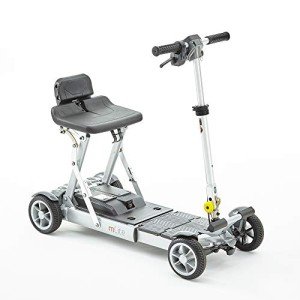Understanding Mobility Aids: Enhancing Independence and Quality of Life
As society continues to age and people progressively look for ways to preserve independence, the need for mobility aids has actually never been more pertinent. Mobility aids, which incorporate a range of devices designed to help individuals with walking or moving around, play a crucial role in promoting mobility, improving safety, and improving overall quality of life. This blog post will check out the various kinds of mobility aids, their advantages, factors to consider for choice, and answer some often asked concerns.
Types of Mobility Aids
Numerous mobility aids are available, each designed to resolve specific needs. The following table summarizes a few of the most typical kinds of mobility aids and their features.
| Kind Of Mobility Aid | Description | Best Suited For | Key Features |
|---|---|---|---|
| Walking sticks | A portable stick offering assistance and balance. | People who require minimal assistance. | Light-weight, portable, adjustable height. |
| Walkers | Four-legged frames offering stability. | Those requiring substantial support while walking. | Foldable, some with wheels, included safety features. |
| Rollators | Wheeled walkers with a seat for resting. | People requiring mobility with the option to rest. | Brakes, baskets for personal products, adjustable height. |
| Wheelchairs | Chairs with wheels for individuals with limited mobility. | Those not able to stroll or requiring comprehensive support. | Handbook or powered options, customizable seating. |
| Scooters | Motorized devices for larger distances. | Individuals with restricted stamina but needing self-reliance. | Various sizes and styles, typically transportable. |
| Crutches | Support devices put under the arms or lower arms. | People recuperating from lower limb injuries. | Adjustable, lightweight, requires upper body strength. |
| Stairlifts | Mechanical devices for moving between floorings. | Users dealing with difficulties in multi-level homes. | Customizable for different staircases, automated. |
Advantages of Mobility Aids
Mobility aids supply a variety of advantages that can considerably improve the lives of people dealing with mobility difficulties. Some significant benefits include:
- Increased Independence: Mobility aids empower people to move easily without counting on others for support, consequently enhancing their self-confidence and self-confidence.
- Improved Safety: Using mobility aids can reduce the danger of falls and injuries, particularly for older adults or those with balance concerns.
- Improved Quality of Life: By facilitating mobility, people can engage in social activities, participate in events, and enjoy life more fully, adding to better psychological and psychological health.
- Rehab Support: After surgical treatment or injury, mobility aids provide essential assistance and stability, assisting in healing and rehab procedures.
- Accessibility: Many mobility aids are developed to be utilized both indoors and outdoors, guaranteeing that individuals can browse different environments with ease.
Elements to Consider When Choosing Mobility Aids
Selecting the appropriate mobility help requires cautious factor to consider of numerous aspects, consisting of:
| Factor | Factors to consider |
|---|---|
| User's Needs | Evaluate the level of mobility needed; consider whether the user requires temporary or long-lasting support. |
| Physical Limitations | Evaluate the user's strength, balance, and coordination to identify the very best type of help. |
| Setting | Consider the primary environments where the aid will be used, such as home, outdoors, or specific surfaces. |
| Weight and Portability | Guarantee that the selected device is workable regarding mobility and storage, especially for outside usage. |
| Budget plan | Mobility aids been available in a variety of rates; think about insurance protection and readily available funding choices. |
| Adjustability | Pick aids that can be changed for height and convenience to accommodate growth or changing requirements. |
Frequently Asked Questions About Mobility Aids
1. How do I know if I require a mobility help?
Lots of factors can signify the need for a mobility aid, such as difficulty strolling or stabilizing, tiredness while standing, or a current surgery impacting mobility. Consulting with a healthcare expert can supply guidance tailored to specific needs.
2. What kinds of mobility aids are covered by insurance?
Coverage varies between insurers, however many offer choices for durable medical equipment, which generally consists of wheelchairs, walkers, and some kinds of canes. Consult your insurance coverage provider for particular protection information.
3. Can mobility aids be used outdoors?
Yes, lots of contemporary mobility aids are designed for outdoor usage. Rollators, scooters, and some walkers are equipped with functions for stability and ease of usage on numerous terrain.
4. How do I keep my mobility help?
Routine upkeep includes examining for any wear and tear, guaranteeing that parts such as wheels, brakes, and frames are functioning correctly, and cleaning up the equipment as required. Following the maker's standards is important for security.
5. Exists a danger of ending up being depending on mobility aids?
While some users might end up being reliant on mobility aids, they are developed to promote independence and mobility. Gradually utilizing a mobility aid can improve self-confidence and assistance maintain physical strength and coordination.
Mobility aids are vital tools that empower people to conquer physical obstacles, promoting self-reliance and enhancing quality of life. By understanding Read Webpage of mobility aids offered, their benefits, and important elements for factor to consider, families and caretakers can make educated choices that best fulfill the requirements of their loved ones. With the right support, those with mobility difficulties can lead satisfying and active lives, complimentary to check out the world around them.

